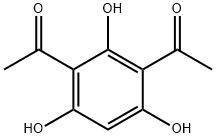1-(3-ACETYL-2,4,6-TRIHYDROXYPHENYL)ETHAN-1-ONE manufacturers
|
| | 1-(3-ACETYL-2,4,6-TRIHYDROXYPHENYL)ETHAN-1-ONE Basic information |
| Product Name: | 1-(3-ACETYL-2,4,6-TRIHYDROXYPHENYL)ETHAN-1-ONE | | Synonyms: | 1,1’-(2,4,6-trihydroxy-1,3-phenylene)bis-ethanon;1,1’-(2,4,6-trihydroxy-1,3-phenylene)bisethanone;diacetyl-phloroglucino;2,4-DIACETYLPHLOROGLUCINOL;K2【pharmaceutical】;K-2【pharmaceutical】;2,4-Diacetylbenzene-1,3,5-triol;1,3-Diacetyl-2,4,6-trihydroxybenzene | | CAS: | 2161-86-6 | | MF: | C10H10O5 | | MW: | 210.18 | | EINECS: | | | Product Categories: | Aromatic Phenols;Aromatics Compounds;Aromatics;Inhibitors | | Mol File: | 2161-86-6.mol |  |
| | 1-(3-ACETYL-2,4,6-TRIHYDROXYPHENYL)ETHAN-1-ONE Chemical Properties |
| Melting point | 164 °C | | Boiling point | 374.7±42.0 °C(Predicted) | | density | 1.422±0.06 g/cm3(Predicted) | | storage temp. | -20°C Freezer | | solubility | DMSO (Slightly), Methanol (Slightly) | | form | Solid | | pka | 7.67±0.28(Predicted) | | color | Pale Orange to Light Beige | | CAS DataBase Reference | 2161-86-6(CAS DataBase Reference) |
| | 1-(3-ACETYL-2,4,6-TRIHYDROXYPHENYL)ETHAN-1-ONE Usage And Synthesis |
| Chemical Properties | Light Pink Solid | | Uses | Diacetylphloroglucinol (DAPG) is a small molecular weight, phenolic metabolite belonging to the phloroglucinol (1,3,5- trihydroxybenzene) family produced by bacteria, including Pseudomonas strains. DAPG exhibits a broad range of biological activities, albeit with mostly low potency. In the search for novel actives, DAPG and related metabolites are important for dereplication to eliminate leads due to high amounts of weakly potent actives. Although weakly active, this family appears to be important in the biocontrol of plant diseases by some Pseudomonas strains. | | Preparation | Preparation by Friedel–Crafts acylation of phloroglucinol,
? with acetic acid,
– by using boron trifluoride-acetic acid complex at
28–30° for 18 h (85%)
with acetic anhydride,
– in the presence of boron trifluoride-ethyl ether complex at 20° for 1 h (80%)
– in the presence of zinc chloride at 145–150° for 15 min (25%);
– in the presence of concentrated sulfuric acid (24%)
? with acetyl chloride,
– (4 equiv.) in the presence of ferric chloride
– in ethyl ether in the presence of aluminium chloride at r.t. for 5 days (8). | | Definition | ChEBI: A benzenetriol that is phloroglucinol in which two of the ring hydrogens are replaced by acetyl groups. | | Biological Activity | 2,4-diacetylphloroglucinol is an agent against various plant pathogenic fungi, viruses, bacteria, and nematodes.2,4-diacetylphloroglucinol, a non-nitrogen-containing compound produced by some isolates of p. fluorescens, has been used to increase crop yield by controlling plant root diseases. | | in vitro | a previous study was conducted to determine if 2,4-diacetylphloroglucinol was toxic to selected nematodes. the plant-parasitic nematodes including pratylenchus scribneri and xiphinema americanum, heterodera glycines, meloidogyne incognita, and the bacterial-feeding nematodes such as pristionchus pacificus, caenorhabditis elegans, and rhabditis rainai, were found to be immersed in concentrations ranging from 0 to 100 μg/ml of 2,4-diacetylphloroglucinol. moreove, the egg hatch and viability of juveniles and adults were determined, and the results showed that 2,4-diacetylphloroglucinol was toxic to x. americanum adults with an ld50 of 8.3 μg/ml. 2,4-diacetylphloroglucinol could decrease m. incognita egg hatch, but stimulated c. elegans hatch. whereas, the viability of m. incognita j2 and of c. elegans j1 and adults was not affected. there were no observed effects on the other nematodes. these findings indicated that 2,4-diacetylphloroglucinol was not toxic to all nematodes, and did not affect the tested species of beneficial bacterial-feeding nematodes [1]. | | references | [1] meyer, s. l.f.,halbrendt, j.m.,carta, l.k., et al. toxicity of 2,4-diacetylphloroglucinol (dapg) to plant-parasitic and bacterial-feeding nematodes. journal of nematology 41(4), 274-280 (2009). |
| | 1-(3-ACETYL-2,4,6-TRIHYDROXYPHENYL)ETHAN-1-ONE Preparation Products And Raw materials |
|